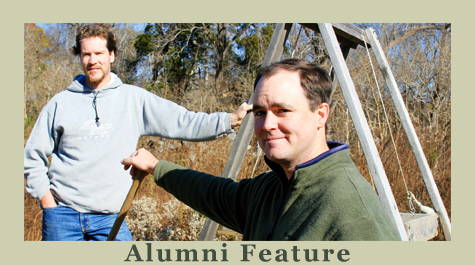Two former W&M roommates find a new kind of home
It is around this place that David Brown ‘96 and Thane Harpole ‘96 have created a nonprofit archaeological foundation to fund its rebirth and recreation as a historical preserve and learning center.
Brown and Harpole met at the College as roommates, and knew then that they would join forces on a project in their shared field of archaeology. While their fellow students worked at digs in Jamestown and for Colonial Williamsburg, Brown and Harpole made their way to Gloucester, where Harpole had previously lived. He'd recognized that there was a wealth of history in Gloucester waiting to be discovered, decoded and cataloged.
In 2000, after earning their master's degrees, the pair returned to Gloucester to set up shop and uncover Fairfield's mysteries.
The original 2,350 acres of land for the plantation was patented in 1648 by Lewis Burwell, and the house was erected by 1694. The home was in the Burwell family for decades, which helped the massive property grow to 7,000 acres. The patriarch of the Burwell family died during the American Revolution, and within a few years the plantation and house were sold to a man named Robert Thruston, who upgraded the style of the exterior, making the mansion more fashionable for the late 18th century.
The Thrustons left in the 1830s, and Fairfield was leased to various African-American tenant farmers, who lived at the property from the 1860s until a fire destroyed everything in 1897.
That is the puzzle of this once-great place. What happened during all those years?
During the spring, summer and fall, Harpole and Brown literally dig through the layers of history at the site to piece together the story. They are also tracking down the few scraps of newspaper and legal papers that survived the centuries in Gloucester.
"We don't have many specific documents - this is where it's so wonderful to see archaeology," says Brown.
This isn't the first time that these two have struck archaeological gold. It was Brown and Harpole who played a major role in identifying Werowocomoco, which is widely agreed to be the home of Chief Powhatan, the father of Pocahontas.
As part of the Werowocomoco Research Group, they work alongside other scholars and interact with the Virginia Indian community. As the directors of excavation at Fairfield from the start, they take the lessons learned at Werowocomoco and can focus on all of the layers of the Burwell plantation, and not just about the wealthy and elite who called the place home.
"With Monticello or Mount Vernon, they focused on the house for so long, and then for the last 15 years they have been playing catch-up in terms of the [history of the] slaves," says Harpole. "Because we are starting from scratch, we can see if we can figure it all out at the same time."
For now, these young researchers are focused on the task at hand, which is working with volunteers and interns from the College to catalog all finds from the site, and they readily admit that the "foundation" portion of their job is the most challenging. Fundraising and marketing aren't exactly staples of an archaeologist's diet, but Brown and Harpole are making it all work.
"It seems that everybody forgets things happened after the Civil War in Virginia," says Brown. "Yet we've got 150 years of dynamic history that needs to be further explored. We are interested in where [the Fairfield artifacts] came from and how they were used and the life stories of the people who were using them."
For more information, visit the Fairfield Foundation at www.fairfieldfoundation.org.
 Skip to main content
Skip to main content

